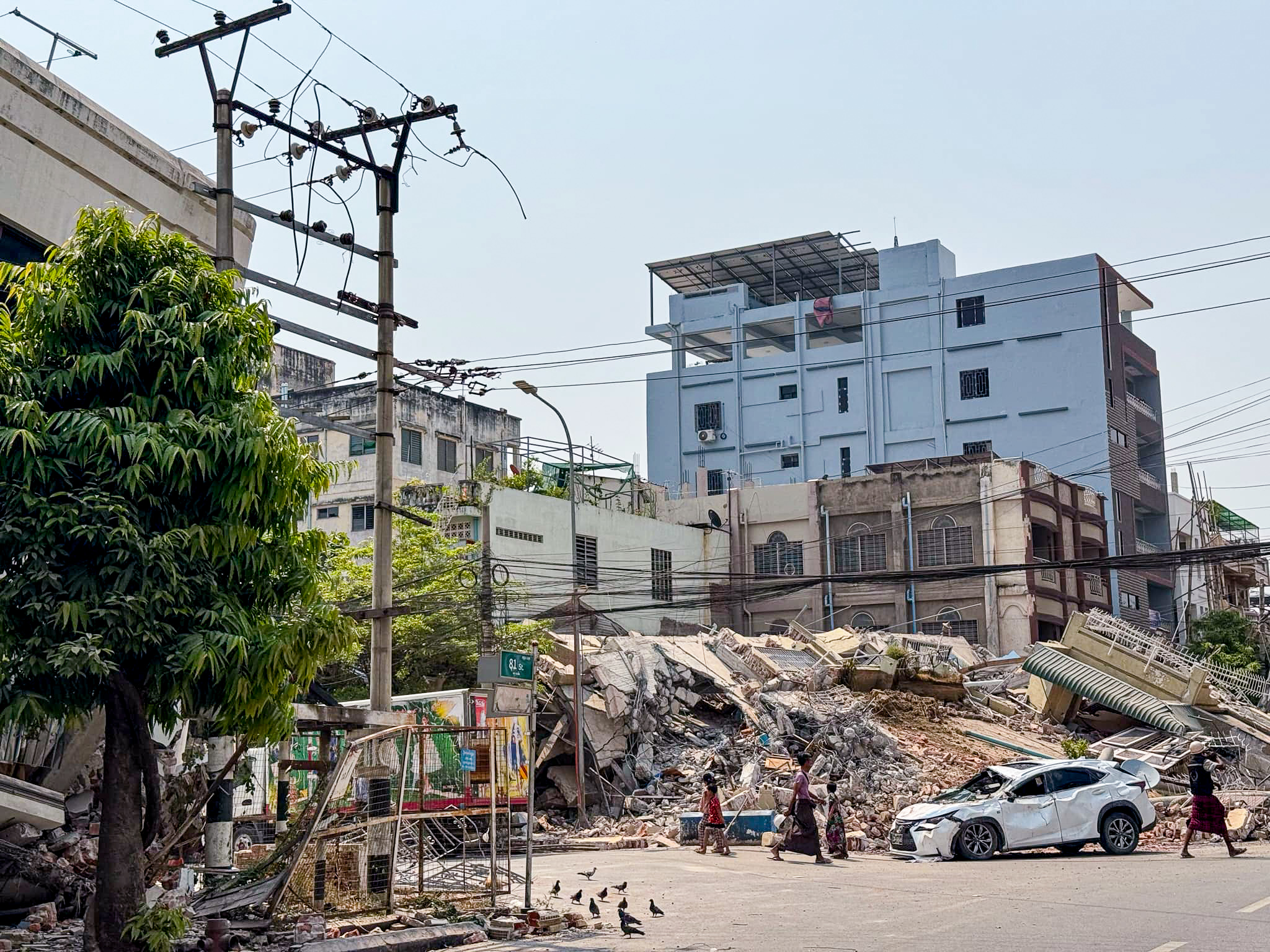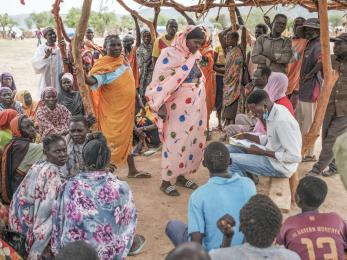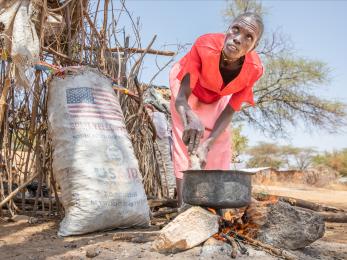A call for ceasefire: Gaza crisis intensifies due to restrictions on humanitarian aid
In February, a crew of workers formed an assembly line through a warehouse in Amman, Jordan. Hundreds of empty boxes rolled across a conveyor, hand-packed and filled with essential food items. The food kits were sealed, wrapped onto pallets, and loaded into a Jordanian Air Force cargo plane bound for Al-Arish, Egypt, more than a hundred miles away. In Egypt, a team of humanitarian workers transferred the food kits from the cargo plane onto trucks to be driven across the Rafah border into Gaza.
At the border crossing, the shipments of Mercy Corps food kits joined a long line of trucks packed with humanitarian aid sitting idly, unsure if or when they could enter Gaza.
Despite the difficulties and uncertainty in delivering aid to Gaza, Mercy Corps’ first shipments have cleared the border. Through our partnerships with local organisations, we’re reaching 1,300 families who have been limited to one meal a day—and at times, skipping meals altogether. Each food kit serves a family of four for a few days and includes ready-to-eat items like canned vegetables, beans, fish, and meat, dried fruits, olive oil, and fortified biscuits—foods that do not rely on cooking fuel, which is unavailable or cost exorbitant prices. Mercy Corps is doing everything we can to help families survive the winter and the siege.
Although a trickle of aid has made it through the checkpoints, humanitarian aid organisations face restrictions due to border closures and limited approvals for which trucks will be rejected or let through. Even if aid trucks are allowed into Gaza, delivery is heavily impeded due to damaged roads and infrastructure, recurrent communications blackouts, and lack of capacity for safe and organised distribution. What little aid that arrives in Gaza barely makes a dent while needs grow dramatically every day.
It is nearly impossible to deliver humanitarian aid in Gaza
Since October 7, the escalation of violence in response to Hamas attacks against Israeli civilians has spiralled into a humanitarian catastrophe of historic proportions in Gaza. Supplies of food, water, fuel, and other basic necessities are depleted and most essential services have completely collapsed. Delivery of humanitarian aid into the isolated region has been obstructed. The majority of humanitarian organisations have not been able to deliver support into Gaza safely or consistently—facing relentless hostilities, active restrictions on aid, and logistical barriers.
Earlier in the conflict, a temporary ceasefire in late November 2023 allowed our team to provide limited humanitarian support in Gaza by distributing locally-sourced food baskets to 1,000 families. But since the return to hostilities, more than 2 million people—half of whom are children—are now stranded with nowhere safe to go, in a state of exhaustion, and in the midst of near total destruction in the Gaza Strip.
Our team members in Gaza have shared first-hand accounts of the devastation they have witnessed and experienced. From fleeing their homes and evading bombings to the desperate struggle to find food, water, and medicine for their families, Palestinians are under siege with no end in sight. The persistent and deliberate denial of humanitarian access into Gaza City and northern communities intensifies the crisis.
“In the north and Gaza City, the aid trucks reaching there are very few, extremely limited, and the assistance doesn't reach anyone in an organised manner,” said Waleed (alias used for security), a team member in Gaza. In the middle of February 2024, an average of 43 trucks entered Gaza per day, compared to 500 trucks delivering goods daily before October 2023.
“Last week, I went to observe the situation of people and trucks and what's happening, and it was very distressing,” said Waleed. “Thousands of people are waiting by the seaside in the hope that aid trucks will enter, and after waiting for hours, only two trucks entered. People crowded around them so intensely, and unfortunately, I personally witnessed two people suffocating to death from the overcrowding.”
People in Gaza are at risk of dying of hunger
“Let’s be clear: People in Gaza are being starved. Hunger is being weaponised. Aid is being actively restricted and blocked,” said Tjada D'Oyen McKenna, Mercy Corps CEO. Half the population of Gaza—1.1 million people—face catastrophic hunger, with Gaza at imminent risk of slipping into famine. The entire population is facing crisis and emergency levels of hunger, further compounded by illness and the spread of disease. The combination of siege tactics, restrictions on aid, and destruction of Gaza’s ability to produce and distribute food has created the conditions for starvation.
“There is no flour or food,” said Asma (alias used for security), a team member in Gaza shared in February 2024. “Everything runs out and doesn't come back in stock. We ground barley, feed, and anything that could be ground to make bread, but even that has run out. Currently, we only eat once a day, and the food is only rice. If the rice runs out, we don't know what we will eat.”
People in Gaza are at risk of dying of hunger just miles from trucks filled with food. In northern Gaza, we have reports of 23 children dying of starvation. According to the World Health Organization, one in three children under the age of two in northern Gaza are acutely malnourished. Even if they escape bombs and bullets, people are dying of hunger and disease.
People in Gaza are being starved. Hunger is being weaponised. Aid is being actively restricted and blocked.
Tjada D'Oyen McKenna, Mercy Corps CEO
The worsening hunger and humanitarian catastrophe is not a byproduct of war. Palestinians are experiencing a man-made, conflict-driven hunger catastrophe inching closer toward famine each day. Never before have today’s humanitarian professionals seen such a high proportion of the population descend so quickly towards catastrophe.
The siege in Gaza must end
No matter what, humanitarian agencies like Mercy Corps remain steadfast in our call for a ceasefire and our commitment to deliver meaningful aid and support to Palestinians.
The aid that is reaching people within Gaza is simply not enough. We are actively coordinating with the U.N., regional, and local partners to advocate for broader and unobstructed humanitarian access into Gaza so we can scale our response efforts—including delivering lifesaving support like food, hygiene supplies, shelter materials, and cash aid—as soon as it is safe to do so. There is no way for humanitarian organisations to deliver meaningful assistance to the 2.3 million people in Gaza who need it without guaranteed safety and access to deliver aid.
Only a sustained ceasefire and an end to the siege coupled with the massive scale-up of humanitarian aid can prevent continued civilian death and destruction in Gaza. Until then, we’ll continue to use our voice, experience, resourcefulness, and partnership with peers and supporters to find ways to deliver relief—and peace.


